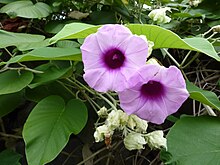This article needs additional citations for verification. (April 2010) |
| Argyreia nervosa | |
|---|---|

| |
| Argyreia nervosa flowers (enlarge) | |
| Scientific classification | |
| Kingdom: | Plantae |
| Clade: | Tracheophytes |
| Clade: | Angiosperms |
| Clade: | Eudicots |
| Clade: | Asterids |
| Order: | Solanales |
| Family: | Convolvulaceae |
| Genus: | Argyreia |
| Species: | A. nervosa
|
| Binomial name | |
| Argyreia nervosa | |
| Synonyms[2] | |
|
Argyreia speciosa (L.f.) Sweet | |
Argyreia nervosa is a perennial climbing vine native to the Indian subcontinent and introduced to numerous areas worldwide, including Hawaii, Africa, and the Caribbean. Though it can be invasive, it is often prized for its aesthetic and medicinal value.[3] Common names include Hawaiian baby woodrose, adhoguda अधोगुडा or vidhara विधारा (Sanskrit), elephant creeper and woolly morning glory. Its seeds are known for their powerful entheogenic properties, greater or similar to those of Ipomoea species, with users reporting significant psychedelic and spiritual experiences.[4][5] The two botanical varieties are A. n. var. nervosa described here, and A. n. var. speciosa, which are used in Ayurvedic medicine for their medicinal value.[3]
Argyreia nervosa seeds contain various ergoline alkaloids such as ergine.[6] A study reported stereoisomers of ergine to be found in the seeds at a concentration of 0.325% of dry weight.[7] A more recent study reported presence of ergometrine, lysergol, lysergic acid and other alkaloids that contribute to its pharmacological effects.[5]
- ^ Glossary Of Indian Medicinal Plants
- ^ "Argyreia nervosa". Germplasm Resources Information Network. Agricultural Research Service, United States Department of Agriculture. Retrieved 2010-11-10.
- ^ a b "Medicinal uses and biological activities of Argyreia speciosa Sweet (Hawaiian Baby Woodrose) — An Overview". Indian Journal of Natural Products and Resources: 286–291. September 2011.
- ^ E. Al-Assmar, Sami (1999). "The Seeds of the Hawaiian Baby Woodrose Are a Powerful Hallucinogen". Arch Intern Med. 159 (17): 2090. doi:10.1001/archinte.159.17.2090 (inactive 2024-11-13). PMID 10510998.
{{cite journal}}: CS1 maint: DOI inactive as of November 2024 (link) - ^ a b Paulke, Alexander; et al. (2015). "Studies on the alkaloid composition of the Hawaiian Baby Woodrose Argyreia nervosa, a common legal high". Forensic Science International. 249: 281–293. doi:10.1016/j.forsciint.2015.02.011. PMID 25747328.
- ^ Halpern, J.H. (2004). "Hallucinogens and dissociative agents naturally growing in the United States". Pharmacology & Therapeutics. 102 (2): 131–138. doi:10.1016/j.pharmthera.2004.03.003. PMID 15163594. S2CID 30734515.
Although LSD does not occur in nature, a close analogue, lysergic acid amide (LSA, ergine) is found in the seeds of Argyreia nervosa (Hawaiian baby woodrose)
- ^ Chao JM, Der Marderosian AH (1973). "Ergoline alkaloidal constituents of Hawaiian baby wood rose, Argyreia nervosa (Burmf) Bojer". J. Pharm. Sci. 62 (4): 588–91. doi:10.1002/jps.2600620409. PMID 4698977.